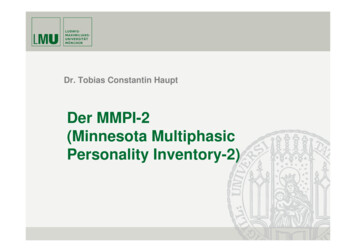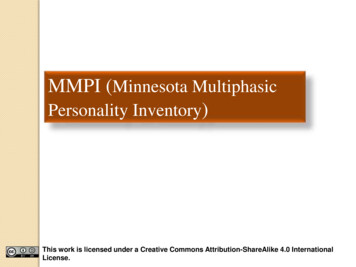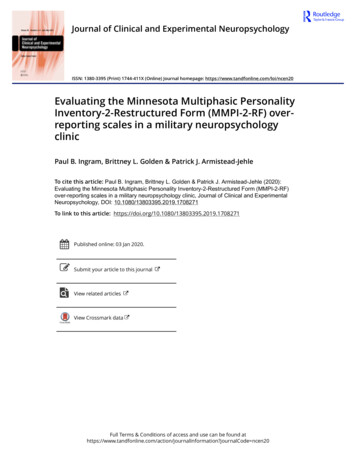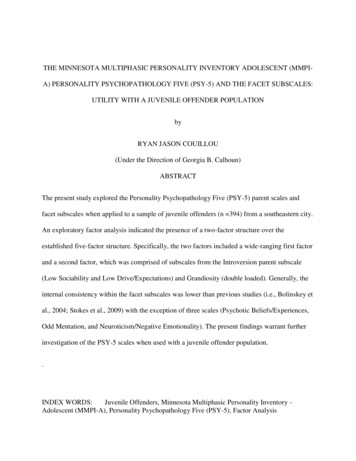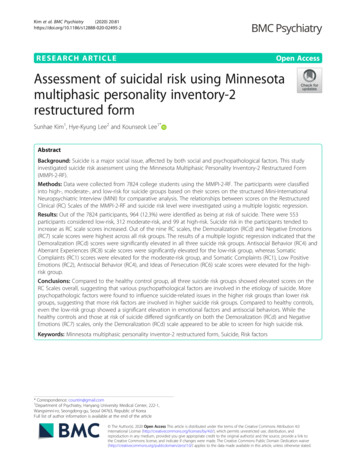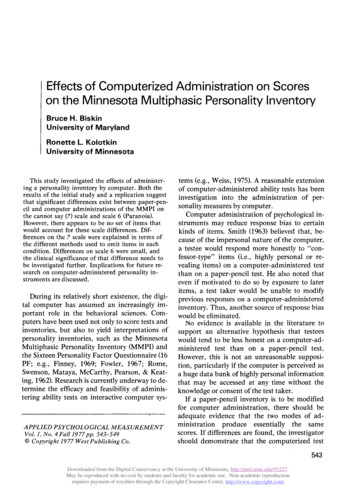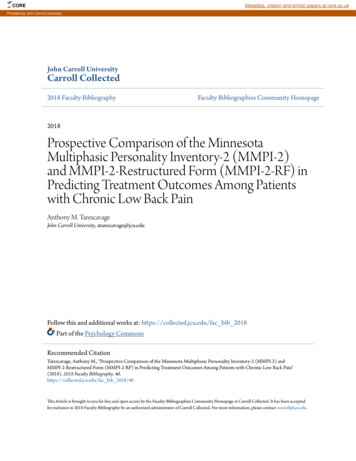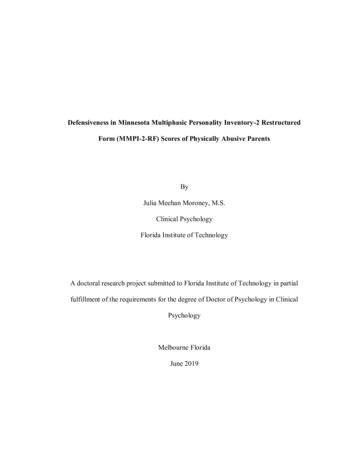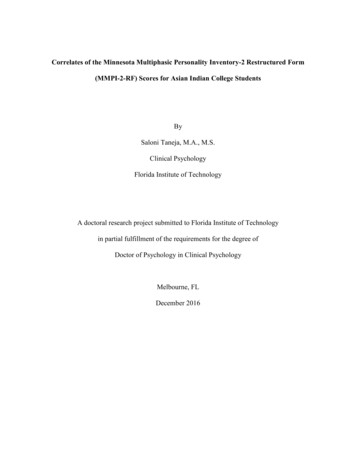
Transcription
Correlates of the Minnesota Multiphasic Personality Inventory-2 Restructured Form(MMPI-2-RF) Scores for Asian Indian College StudentsBySaloni Taneja, M.A., M.S.Clinical PsychologyFlorida Institute of TechnologyA doctoral research project submitted to Florida Institute of Technologyin partial fulfillment of the requirements for the degree ofDoctor of Psychology in Clinical PsychologyMelbourne, FLDecember 2016
We the undersigned committee, hereby approve the attached doctoral research project in partialfulfillment for the degree of Doctor of Clinical PsychologyCorrelates of the Minnesota Multiphasic Personality Inventory-2 Restructured Form (MMPI-2RF) Scores for Asian Indian College StudentsBySaloni Taneja, M.A., M.S.Radhika Krishnamurthy, PsyD, ABAPProfessor, School of PsychologyDoctoral Research Project ChairMaria Lavooy, PhDAssociate Professor, School of PsychologyDoctoral Research Project Committee MemberKunal Mitra, PhDProfessor, Biomedical EngineeringDoctoral Research Project Committee MemberMary Beth Kenkel, PhDDean, College of Psychology and Liberal Arts
AbstractCorrelates of the Minnesota Multiphasic Personality Inventory-2 Restructured Form(MMPI-2-RF) Scores for Asian Indian College StudentsSaloni Taneja, M.A., M.S.Major Advisor: Radhika Krishnamurthy, PsyD, ABAPThis study was designed to investigate empirical correlates of the MinnesotaMultiphasic Personality Inventory-2-Restructured Form (MMPI-2-RF) for AsianIndian college students using the NEO Five Factor Inventory-3, CollegeMaladjustment Scales and Measures of Psychosocial Development. The study utilizedan Asian Indian college student sample (N 48) from a private university in Florida.Pearson Product Moment correlations were computed to establish correlates of theMMPI-2-RF scale scores. Overall, a large number of significant correlates with largeeffect sizes were found across the three measures. Some correlates found in the studyprovided an expansion for the interpretation of the MMPI-2-RF scales for AsianIndian college students. The study also aimed to identify similarities and differences inpersonality patterns of Asian Indian and Caucasian American college students (N 21)by comparing their mean MMPI-2-RF scale scores. Multivariate and Univariateanalysis of results were not significant, but useful trends of differences were found forsome scales. Lastly, the study examined similarities and differences in personalitypatterns of high and low acculturated Asian Indian college students and correlates ofthe MMPI-2-RF scales separately for these subgroups. A higher number of correlateswere found between MMPI-2-RF scale scores and the three external measures forthose low on acculturation. Limitations, contributions and future research directionsare discussed.iii
Table of ContentsIntroduction . . .1Review of Literature . . .3Personality: Definitions and Descriptions . . 3Culture and Personality .6Personality Assessment .9Self-report inventories. .10Performance-based personality assessment.11The MMPI, MMPI-2, and MMPI-2-RF . . .13The Minnesota Multiphasic Personality Inventory . . .13The Minnesota Multiphasic Personality Inventory-2 . 16The Minnesota Multiphasic Personality Inventory-2-RF .20MMPI, MMPI-2, MMPI-2-RF with Cultural Groups . .25International Adaptations of the MMPI/MMPI-2 . .25Use and adaptations in Asia . . .25Use of the MMPI, MMPI-2 and MMPI-2 RF with Ethnic Groups . . .27Hispanic, Mexican and Mexican American studies . .28Asian and Asian American Studies .30Correlates of the MMPI/MMPI-2/MMPI-2-RF with College Students. . .32MMPI/MMPI-2/MMPI-2-RF with College Students from Various CulturalGroups .39iv
African American students . . .39Mexican/Hispanic students .41Asian and Asian American students . . .42MMPI and Asian Indians . . 43Use of the MMPI in India . . 43Use of the MMPI with Asian Indian college students in the U.S . 44Rationale and Hypotheses . 47Methods . 50Participants . . .50Instruments . 52Procedure . . .56Data Analyses .55Results . . 58Discussion .82References .89Appendix A: Expanded Correlates for the MMPI-2-RF for Asian Indian CollegeStudents .105Appendix B: Acculturation Scale for Asian Indians .115Appendix C: Participant Informed Consent Form . .120v
List of TablesTable 1Validity and Clinical Scales of the MMPI and MMPI-2 . 19Table 2MMPI-2-RF Scales and Measured Characteristics . .21Table 3MMPI-2-RF means and standard deviations for the Asian Indian sample .58Table 4MPD Negative Scale means and standard deviations for the Asian Indiansample . .60Table 5NEO-FFI-3 means and standard deviations for the Asian Indian sample . 60Table 6CAS means and standard deviations for the Asian Indian sample . 61Table 7MMPI-2-RF means and standard deviations for the Caucasian American sample. 62Table 8NEO-FFI-3 correlates of the MMPI-2-RF scale scores for Asian Indian students .64Table 9CAS correlates of the MMPI-2-RF scale scores for Asian Indian students . 66Table 10MPD Negative Scale correlates of the MMPI-2-RF scale scores for Asian Indianstudents . 70Table 11MMPI-2-RF 3 means and standard deviations for high and low acculturated AsianIndian students . 74Table 12Significant NEO-FFI-3 correlates of the MMPI-2-RF scale scores for low and highacculturated Asian Indianstudents . 75vi
Table 13Significant CAS correlates of the MMPI-2-RF scale scores for low and highacculturated Asian Indian students . 76Table 14Significant MPD Negative Scale correlates of the MMPI-2-RF scale scores for lowand high acculturated Asian Indianstudents . 78Table 15Expanded correlates for the MMPI-2-RF for Asian Indian collegestudents . 105vii
Correlates of the MMPI-2-RF for Asian Indians 1IntroductionAsian Indian migrants began arriving in the United States as early as 1820.Although few in number at the time, the Indian population surged since the 1990sand 2000s and has become the third largest Asian immigrant group in the UnitedStates (U.S. Census Bureau, 2010). According to census statistics, there was a67.6% increase in the number of Asian Indians where the total number of AsianIndian immigrants increased from 1,899,599 in 2000 to 3,183,063 in 2010.Currently, the Asian Indian population constitutes 9.1% of the total Asianpopulation in the United States (U.S. Census Bureau, 2010). More than half ofIndian immigrants in the United States obtain lawful permanent residence throughthe employment-based preference option.Among the international college student population, close to 103,000 AsianIndian students were enrolled in U.S. educational institutions in the 2013-14 schoolyear (U.S. Citizenship and Immigration Services, 2015). It is likely that withincreasing number of college and university students, some percentage of studentswill receive psychotherapy and psychological testing. There are greater demandson college counseling centers today to diagnose and treat various types of studentrelated problems, ranging from adjustment problems to severe psychopathology.International students bring with them their own cultural reference points forbehavioral functioning, some of which differ substantially from American norms.Thus, they may appear out-of-step from their American peers, at least initially.Furthermore, the transition to a new cultural environment makes demands onprocesses of adaptation and acculturation, and some international students copewith these challenges more successfully than others.
Correlates of the MMPI-2-RF for Asian Indians 2Personality assessment measures such as the Minnesota MultiphasicPersonality Inventory (MMPI/MMPI-2) are an important tool to aid collegecounseling centers in accomplishing their goals of aiding student adjustment. Likeits previous versions, the Minnesota Multiphasic Personality Inventory-2Restructured Form (MMPI-2-RF; Tellegen & Ben-Porath, 2008) is fast gainingpopularity as a personality measure for assessing and diagnosing personalityattributes and psychological disturbances in college students. However, thereappears to be very limited research on the Asian Indian population with the MMPIand its later versions. The purpose of this study was to expand descriptorsassociated with MMPI-2-RF scores specifically for the Asian Indian population,and examine similarities and differences in MMPI-2-RF scores of Asian Indianand Caucasian American college students in order to enhance the future use of thistest with Asian Indians in the United States.
Correlates of the MMPI-2-RF for Asian Indians 3Review of LiteraturePersonality: Definitions and DescriptionsPersonality can be defined as “those characteristics of the person thataccount for consistent patterns of feeling, thinking, and behaving” (Pervin,Cervone, & John, 2005, p. 6). Therefore, personality is believed to be enduringand relatively stable across situations, contexts and interactions. Some theoristsemphasize the integrative or organizational structure of personality, which depictspersonality as a pattern across various individual behaviors resulting from theorganization (Hall & Lindzey, 1957). This conceptualization suggests thatpersonality gives order to individuals’ interactions with themselves and theirenvironments. Another way to define personality is by looking at its function inmediating an individual’s adjustment in his or her context, and thus consists ofovert and covert efforts at adjustment carried out by the individual (Hall &Lindzey, 1957). Martinez and Oishi (2006) identified affect, thinking, behaving,self-concept, motivation, and values as some core components of personality.Of the many theories of personality conceptualized by various theorists,trait-based approaches gained significant importance historically and continue tobe popular (Mischel, 1981). Trait refers to a distinguishing characteristic of aperson that is characterized by consistency in the way an individual will display itacross situations. According to personality researchers, the most fundamentalviewpoint of trait theories is that people possess dispositions, which determines thestrength of an individual’s tendency to behave in a particular manner. Therefore, arelated assumption is that there is a direct agreement between an individual’s traitand performance of his or her trait-related behaviors (Pervin et al., 2005).
Correlates of the MMPI-2-RF for Asian Indians 4Spielberg (1985) described these behaviors as states and defined them as observedexpressions of personality. He gave an analogy of energy to describe therelationship between the two and stated, “trait anxiety would be equivalent topotential energy, and state to kinetic energy.” (Spielberg, 1970, p. 3).Traits are identified as the most enduring aspects of personality, and a vastamount of literature establishes stability in personality through longitudinalresearch on traits. The stability of personality is evaluated in relation totemperament, as predictive links have been established between childhoodtemperament type and adult personality. For example, a longitudinal research studyfound that early temperamental tendencies of 1000 individuals tested as babieswere significantly correlated with their personality characteristics as adults whentested after 23 years, indicating foundations of personality in early years andstability and continuity of traits over time (Caspi, Harrington, Milne, Theodore &Moffitt, 2003).In further attempts to determine the stability of personality, findings fromresearch studies other than on temperament focused on trait-score correlationsusing rank-order correlation, and meta analytic data on test-retest correlations(McCrae & Costa, 1999). The Five Factor Model (FFM) of personality (McCrae &Costa, 1999) explains personality in terms of the five core traits of openness toexperience, conscientiousness, extraversion, agreeableness and neuroticism.Empirical findings based on this model have shown stability in personality traitsacross time and suggest that most changes in personality are limited to earlyadulthood. This is supported by rank-order correlations that measure consistencyand stability in personality traits by assessing homogeny in a group of scores
Correlates of the MMPI-2-RF for Asian Indians 5obtained on a particular trait across multiple measurements in time (Roberts &DelVecchio, 2000). Research in this area has indicated that rank-order correlationsin adolescence range from .30 to .60, which is considered significant asadolescence is deemed a period of intense life changes (Roberts, Caspi & Moffitt,2001). Findings have also indicated modest changes during early adulthood, but itis found that the probability of these changes declines beyond 30 years of age asrank-order correlations have revealed a range of .60 to .80 over a period ofapproximately 20 years (McCrae, Herbst, Costa, & Siegler, 2000).Additional literature that supports the idea of stability of personality traitsuses meta-analytic data of test-retest correlations. Research has found that stabilityin traits increases from .31 in childhood to .74 between 50 and 70 years of age(Roberts & DelVecchio, 2000). Moderate correlations are found below the age of50, indicating unlikelihood of dramatic changes in personality over time.Zuckerman (1995) provided a biological explanation for stability of traits,proposing that neural connections in the brain manifest in particular traits and asubstantial amount of redirection or change in patterns of neuronal firing will berequired to bring drastic changes in traits. Therefore, his findings arecommensurate with the notion that personality traits are increasingly stable overtime.While rank-order correlation and meta-analytic methods argue in favor ofstability, studies on intra-individual personality trait changes challenge thisassumption and indicate significant within-person changes in traits. For example,research by Scollon and Diener (2006) revealed that there were notable withinperson changes in extraversion and neuroticism when tested over a span of eight
Correlates of the MMPI-2-RF for Asian Indians 6years beyond the age of 30 years. To conclude the debate, McAdams and Pals(2006) proposed that among factors such as maturation and characteristicadaptations that result in modest changes in traits, personality is also influenced bycultural and social contexts. The following section provides an account of interplaybetween those cultural factors and personality development and testing.Culture and PersonalityCulture is defined as shared meaning systems comprised of values andnorms that guide people of a particular group. These values and norms are said tobe maintained between generations and are transmitted through language,practices, social institutions and shared narratives (Senior & Bhopal, 1994; Markus& Kitayama, 1998). Over several decades of research, social scientists haveindicated that cultural influences have significant deterministic psychologicaleffects on the developing personalities of individuals. However, more recenttheorists propose that culture only provides a probabilistic influence on anindividual’s behavior (Stryker & Burke, 2000).The study of culture and personality emerged in the beginning of the 20thcentury (Benedict, 1934), and ever since there have been challenges in determiningthe relationship between the two and achieving a balance between universalities inpersonality types and cultural uniqueness in personality (Cheung, Vijver, & Leong,2011). Historically, two major camps in research of cultural influences onpersonality emerged: cross-cultural and cultural psychology (Kwan & Hermann,2015). Cross-cultural psychologists argue that culture is an independent factor thatshapes personality and postulate that all individuals have the same psychologicalmake-up indicating universality of personality characteristics (Church, 2000). For
Correlates of the MMPI-2-RF for Asian Indians 7example, research on social axioms revealed that there is a universal centralprocessing mechanism for all people across all cultural contexts (Bond, 2000).Cultural psychology, on the other hand, recognized personality as a result of anindividual’s interactions with his or her culture (Church, 2000). Therefore, culturalresearchers assume that personality components are constructed socially and traitsdiffer across cultural contexts. For example, in a study on open-ended descriptionsof people provided by American and Hindu participants, it was found that Hinduparticipants tended to provide descriptions involving collectivistic concepts thatwere derived from their cultural context, whereas the American participants’descriptions were free of such contextual connotations, indicating an autonomousperson concept (Shweder & Bourne, 1984). Therefore, three prominent goals ofstudying culture and personality have been identified (Berry, Poortinga, Segall, &Desan, 2002). The first goal, called “transport and test” (Berry et al., 2002, p.3),aims to study Western concepts and constructs in other cultures to assess theirgeneralizability and validity across cultures; therefore, the methods used to studythese dimensions are also Western. The five-factor theory is an apt example of thisgoal (McCrae & Terrancciano, 2005). The second goal pertains to exploring othercultures in order to find culture-specific phenomena. Using a lexical approach, theresearchers identify local phenomena and use factor analysis to derive culturallymeaningful personality dimensions. These are then compared against Westerndimensions to identify cross-cultural similarities and differences (Ashton & Lee,2005). The third goal of cross-cultural psychology is to combine results obtainedfrom pursuit of the first two goals to derive relatively universal constructs in orderto universalize concepts of personality. Consistent with the aforementioned goals,
Correlates of the MMPI-2-RF for Asian Indians 8two prominent methods of studying the relationship between personality andculture are the etic and emic approaches. Etic approaches are closely related to thefirst goal and investigate the universal applicability of Western approaches with anaim of establish generalizability and cross-cultural validity of concepts andmethods (Cheung et al., 2011). The FFM is an apt example of this approach(McCrae & Terrancciano, 2005). The etic approach aims to establish equivalence,which refers to the strength of comparability of personality constructs andphenomena when tested across multiple cultural groups. The emic approach, whichcorresponds to the second goal of study of culture and personality, uses methods toinvestigate culture-specific or indigenous phenomena. Researchers who use thisapproach typically begin by generating a list of adjectives to describe personalityusing a lexical approach, and then employ factor analysis to identify traits orconstructs important to that culture. These constructs are then compared againstWestern dimensions to investigate similarities and differences (Ashton & Lee,2005). Using the emic approach, research has revealed personality andpsychopathology patterns that influence health seeking behaviors among AsianIndian people living in the United States. Research suggests that Asian Indians findit difficult to express their difficulties openly even though anxiety and depressionare significantly prevalent among this population, indicating a need for selfconcealment. (Khanna, McDowell, Perumbilly, & Titus, 2009; Masuda & Boone,2011). This is also explained from a larger cultural perspective of Asians. Researchon culturally driven syndromes suggests that Asians are prone to exhibitpsychological difficulties through somatization tendencies (American PsychiatricAssociation, 2000). It is also found that Asian cultural groups tend to emphasize
Correlates of the MMPI-2-RF for Asian Indians 9restraining of emotions and believe in suppressing emotions of anger, which resultsin symptoms of insomnia, panic, indigestion and generalized aches and pains (Min& Lee, 1989). In the domain of relationships, it is found that Asians have acollectivistic orientation highlighting the importance of social context on theirattitudes and behaviors (Khanna et al., 2009). Researchers have also found thetendency towards passivity in relationships, indicating that those from an Asianorigin define themselves in the context of their relationships with those aroundthem (Markus & Kitayama, 1998).Recent theorists are of the view that many personality dimensions areuniversal, but manifestations of those dimensions differ across cultures. Therefore,a combined etic-emic approach to personality assessment has been proposed. Thisnew approach uses integrated methods to balance the focus on culture-specific anduniversal components of personality. This view is supported by the work on theFFM, which claims that while personality traits of neuroticism, extraversion,openness, agreeableness, and conscientiousness are universal, it is possible toinvestigate differences in meanings, perceptions and demonstration of these traitsbased on the specific culture studied (McCrae, 2000).Personality AssessmentThis section describes the historical foundations of personality assessment,which led to current assessment methods and applications. Attempts to developstructured methods of personality assessment began in the 19th century, whichsubsequently resulted in two historical trends. One such trend leaned towards‘phrenology,’ which entailed measuring peoples’ characteristics by assessing theirhead size and shape. The other movement, led by Francis Galton, focused on
Correlates of the MMPI-2-RF for Asian Indians 10devising scientific observation and methods, which influenced personality testdevelopments of the later half of the 19th century (Butcher, 2010). Clinicalpsychology began with psychological assessment, and during the two world wars,clinical psychology was typified and recognized primarily by psychologicalassessment. In the United States, introduction and use of personality assessmentwas catalyzed by the need to develop instruments to screen for psychological andpsychiatric difficulties among those drafted into the U.S Army. Two primary typesof personality assessments methods emerged: self-report inventories andperformance-based techniques (Benjamin, 2005).Self-report inventories. These are the most common and direct methods toinvestigate an individual’s problems and attributes (Butcher, Bubany, & Mason,2013). Self report methods typically consist of self-descriptive statements that arerated either by answering “yes” or “no”, or follow a Likert-type rating scale. Thefirst formal self-report measure to assess personality characteristics, developed andpublished by Heymans and Wiersma (1906), assessed personal qualities using a90-item structured rating scale. Subsequent years saw the development of selfreport measures using diverse test construction approaches. One such class ofpersonality questionnaires consisted of theoretically influenced, one-dimensionalpersonality inventories. This approach to personality assessment methods is basedon face validity of test items so as to ensure utility and relevance of the test. Onesuch test, constructed by Robert Woodworth, was the Personal Data Sheet, whichaimed to screen for maladjustment in draftees during World War 1 (Woodworth,1920). Another group of tests can be classified as theoretically derivedmultidimensional personality inventories that widened the scope of personality
Correlates of the MMPI-2-RF for Asian Indians 11assessment by including more than one personality dimension in a single test.Bernreuter (1931) and Humm and Wadsworth (1934) used this approach toconstruct their measures. Another very different approach relied on empiricalapproach to construct test items. The earlier tests were influenced by developers’judgments in constructing the tests and were not empirically derived, thus raisingquestions about the validity of the test scores. The empirical methods postulatedthat items must be tested before being included in the test. The MinnesotaMultiphasic Personality Inventory (MMPI), developed by Hathaway andMcKinley (1943), was the first test based on strict empirical validation.Factor analysis was another method used by test developers to constructinventories. This method, pioneered by Cattell in the 1940s (Cattell, 1946), appliedcorrelational-statistical techniques to derive test items from a pool of items so as toincrease homogeneity in the dimension being measured. In using a modifiedversion of the factor analytic approach, Jackson (1970) proposed a sequentialsystem of first selecting theoretically based items, then applying factor analysis toensure scale homogeneity and high correlation with the total score. Anothercategory of self-report measures is content-based, which is a combination oftheoretical and correlational methods described earlier. Items are first groupedbased on similarity in content and statistical analysis is then conducted for itemanalysis to ensure that the items are close to the construct being measured (Butcheret al., 2013).Performance-based personality measures. In contrast to self-reportinventories, performance-based measures, also referred to as free-responsemethods, sample people’s performance on various tasks. As an example, people
Correlates of the MMPI-2-RF for Asian Indians 12may be required to develop narratives or verbalize their perceptions to ambiguousstimuli as in the Rorschach Inkblot Test (Weiner, 2013). Personality-basedmeasures, therefore, require the test taker to perform a task that is intended touncover or elicit insight into the dynamics of their personality.Performance-based measures contribute to the domain of personality inthree different ways. First, they give insight into attributes or characteristics ofwhich the individual is not fully aware or willing to disclose. According to Weiner(2013), although performance-based interpretations are less definitive and moreopen to inference than self-report personality measures, they give informationabout personality patterns that cannot be assessed directly on self-reportinventories. Second, these measures reduce impression management by theexaminee because they are not face valid. According to Weiner (2013),performance based measures also provide more opportunity for interaction anddialogue between the examiner and respondent, which is less available when usingself-report measures. Therefore, they also give an examiner the means to assess forthe respondents’ interpersonal styles and dynamics.Personality assessments are used for a variety of purposes in educational,forensic, and occupational settings, but they can be broadly classified into twocategories, namely clinical evaluation and assessment of ‘normal’ personalitycharacteristics. Clinical treatment settings are the most popular and traditionalareas of personality assessment applications (Weiner & Greene, 2008). Clinicalpersonality assessments facilitate decision-making for treatment, provide a methodfor measuring the client’s progress, and clarify the nature and extent ofpsychological problems experienced by the examinee. Clinical personality
Correlates of the MMPI-2-RF for Asian Indians 13assessment is a useful tool for psychologists as it can provide information aboutclients’ personality strengths, weaknesses, coping styles, needs, concerns, attitudestoward themselves and others, and their abilities to adapt to life’s circumstances(Weiner & Greene, 2008). The MMPI and its revised 2nd edition, the MMPI-2(Butcher, Dalhstrom, Graham, Tellegen, & Kaemmer, 1989) is the mostextensively used measure for clinical personality assessment, and the research on itis ever expanding. The second group of personality measures is constructed toobtain information about ‘normal’ personality traits that can be useful to describecharacteristics ways of functioning. One such measure is the NEO PersonalityInventory, which is based on the FFM, and organizes personality in terms of fivebasic dimensions: Extraversion, Agreeableness, Conscientiousness, Neuroticism,and Openness to Experience (Costa & McCrae, 1995). The FFM is based uponfactor analytic research on the structure of personality (Costa & McCrae, 1992); itis a measure of normal personality traits but has also been used in clinicalassessments.The MMPI, MMPI-2, and MMPI-2-RFMinnesota Multiphasic Personality Inventory. Hathaway and McKinley(1943) developed the MMPI with the purpose to construct a personality inventorythat would prove efficient and reliable in assessing personality characteristics andfacilitating diagnosis (Graham, 2012).To construct the basic MMPI scales, Hathaway and McKinley (1943)initially collected a large number of items that consisted of personality-relatedstatements from psychiatric case histories and reports, textbooks and previouslypublished personality and social measures. The authors used an empirical keying
Correlates o
its previous versions, the Minnesota Multiphasic Personality Inventory-2-Restructured Form (MMPI-2-RF; Tellegen & Ben-Porath, 2008) is fast gaining popularity as a personality measure for assessing and diagnosing personality attributes and psychological disturbances in college students. However, there

